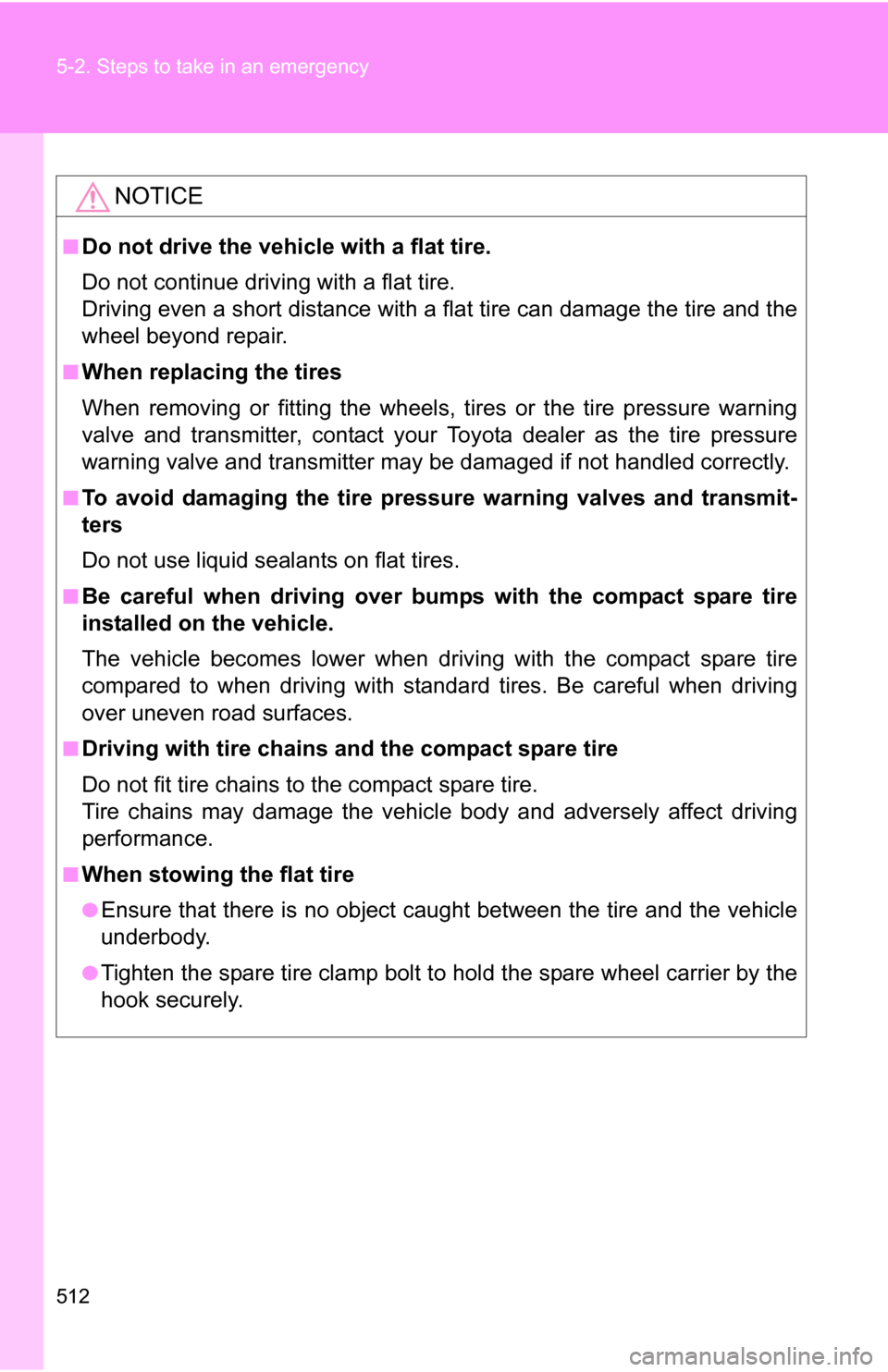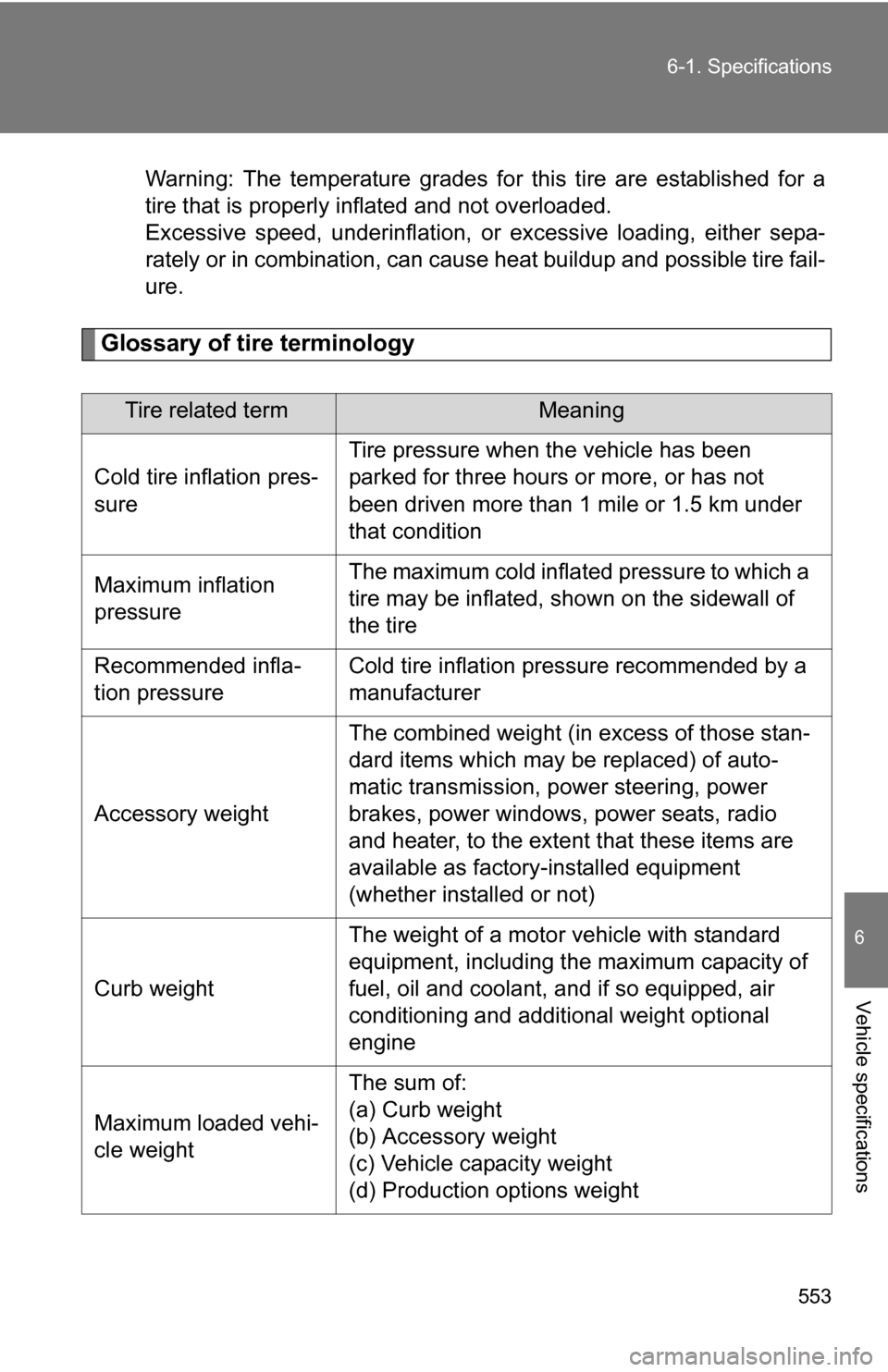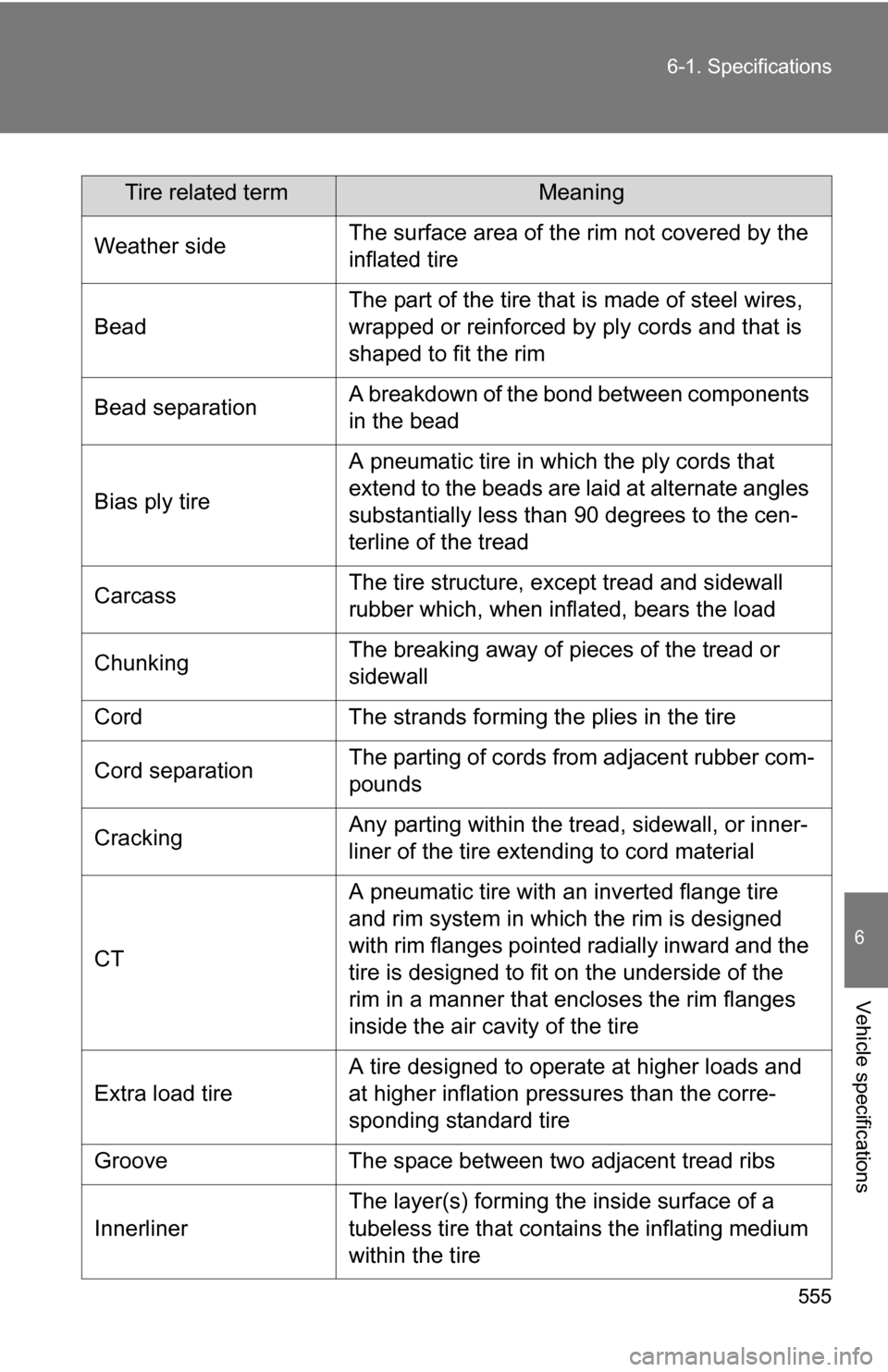Page 512 of 580

512 5-2. Steps to take in an emergency
NOTICE
■Do not drive the vehicle with a flat tire.
Do not continue driving with a flat tire.
Driving even a short distance with a flat tire can damage the tire and the
wheel beyond repair.
■When replacing the tires
When removing or fitting the wheels, tires or the tire pressure warning
valve and transmitter, contact your Toyota dealer as the tire pressure
warning valve and transmitter may be damaged if not handled correctly.
■To avoid damaging the tire pressure warning valves and transmit-
ters
Do not use liquid sealants on flat tires.
■Be careful when driving over bumps with the compact spare tire
installed on the vehicle.
The vehicle becomes lower when driving with the compact spare tire
compared to when drivin g with standard tires. Be careful when driving
over uneven road surfaces.
■Driving with tire chains and the compact spare tire
Do not fit tire chains to the compact spare tire.
Tire chains may damage the vehicle body and adversely affect driving
performance.
■When stowing the flat tire
●Ensure that there is no object caught between the tire and the vehicle
underbody.
●Tighten the spare tire clamp bolt to hold the spare wheel carrier by the
hook securely.
Page 539 of 580
539
6-1. Specifications
6
Vehicle specifications
Tires and wheels
Type A
Tire size P245/65R17 105S
Tire inflation pressure
(Recommended cold tire
inflation pressure) Driving under normal conditions
Front:
33 psi (230 kPa, 2.3 kgf/cm
2 or bar)
Rear:
33 psi (230 kPa, 2.3 kgf/cm
2 or bar)
Spare:
33 psi (230 kPa, 2.3 kgf/cm
2 or bar)
Driving at high speeds above 100 mph
(160 km/h) (in countries where such speeds
are permitted by law) Add 5 psi (30 kPa, 0.3 kgf/cm
2 or bar) to the
front tires and rear tires. Never exceed the
maximum cold tire infl ation pressure indi-
cated on the tire sidewall.
Wheel size 17 7 1/2 J
Wheel nut torque 76 ft•lbf (103 N•m, 10.5 kgf•m)
Page 540 of 580
540 6-1. Specifications
Type B
Tire sizeP245/55R19 103S
Tire inflation pressure
(Recommended cold tire
inflation pressure) Driving under normal conditions
Front:
33 psi (230 kPa, 2.3 kgf/cm
2 or bar)
Rear:
33 psi (230 kPa, 2.3 kgf/cm
2 or bar)
Spare:
33 psi (230 kPa, 2.3 kgf/cm
2 or bar)
Driving at high speeds above 100 mph
(160 km/h) (in countries where such speeds
are permitted by law) Add 5 psi (30 kPa, 0.3 kgf/cm
2 or bar) to the
front tires and rear tires. Never exceed the
maximum cold tire infl ation pressure indi-
cated on the tire sidewall.
Wheel size 19 7 1/2 J
Wheel nut torque 76 ft•lbf (103 N•m, 10.5 kgf•m)
When towing a trailer, drive with the tires inflated as outlined below
Tire inflation pressure
(Recommended cold tire
inflation pressure) Add 3 psi (20 kPa, 0.2 kgf/cm2 or bar) to the
rear tires. Never ex ceed the maximum cold
tire inflation pressure indicated on the tire
sidewall.
Page 541 of 580
541
6-1. Specifications
6
Vehicle specifications
Type C
Tire size
P245/65R17 105S, T165/90D18 107M
(spare)
Tire inflation pressure
(Recommended cold tire
inflation pressure)Driving under normal conditions
Front:
33 psi (230 kPa, 2.3 kgf/cm
2 or bar)
Rear:
33 psi (230 kPa, 2.3 kgf/cm
2 or bar)
Driving at high speeds above 100 mph
(160 km/h) (in coun tries where such
speeds are permitted by law) Add 5 psi (30 kPa, 0.3 kgf/cm
2 or bar) to
the front tires and rear tires. Never
exceed the maximum cold tire inflation
pressure indicated on the tire sidewall.
Spare:
60 psi (420 kPa, 4.2 kgf/cm
2 or bar)
Wheel size 17 7 1/2 J, 18 4T (spare)
Wheel nut torque 76 ft•lbf (103 N•m, 10.5 kgf•m)
Page 542 of 580
542 6-1. Specifications
Type D
Tire sizeP245/55R19 103S, T165/90D18 107M
(spare)
Tire inflation pressure
(Recommended cold tire
inflation pressure)Driving under normal conditions
Front:
33 psi (230 kPa, 2.3 kgf/cm
2 or bar)
Rear:
33 psi (230 kPa, 2.3 kgf/cm
2 or bar)
Driving at high speeds above 100 mph
(160 km/h) (in countries where such
speeds are permitted by law) Add 5 psi (30 kPa, 0.3 kgf/cm
2 or bar) to
the front tires and rear tires. Never
exceed the maximum cold tire inflation
pressure indicated on the tire sidewall.
Spare:
60 psi (420 kPa, 4.2 kgf/cm
2 or bar)
Wheel size 19 7 1/2 J, 18 4T (spare)
Wheel nut torque 76 ft•lbf (103 N•m, 10.5 kgf•m)
When towing a trailer, drive with the tires inflated as outlined below
Tire inflation pressure
(Recommended cold tire
inflation pressure) Add 3 psi (20 kPa, 0.2 kgf/cm2 or bar) to the
rear tires. Never ex ceed the maximum cold
tire inflation pressure indicated on the tire
sidewall.
Page 548 of 580
548 6-1. Specifications
Radial tires or bias-ply tires
A radial tire has RADIAL on the sidewall. A tire not marked with
RADIAL is a bias-ply tire.
TUBELESS or TUBE TYPE
A tubeless tire does not have a tube and air is directly filled in the
tire. A tube type tire has a tube inside the tire and the tube main-
tains the air pressure.
Load limit at maximum cold tire inflation pressure ( P. 553)
Maximum cold tire in flation pressure ( P. 553)
This means the pressure to which a tire may be inflated.
Uniform tire quality grading
For details, see “Uniform tire quality grading” that follows.
Summer tire or all season tire ( P. 551)
An all season tire has “M+S” on the sidewall. A tire not marked
“M+S” is a summer tire.
TEMPORARY USE ONLY ( P. 509)
A compact spare tire is identified by the phrase “TEMPORARY USE
ONLY” molded into its sidewall. This tire is designed for temporary
emergency use only.
Page 553 of 580

553
6-1. Specifications
6
Vehicle specifications
Warning: The temperature grades for this tire are established for a
tire that is properly inflated and not overloaded.
Excessive speed, underinflation, or
excessive loading, either sepa-
rately or in combination, can caus e heat buildup and possible tire fail-
ure.
Glossary of tire terminology
Tire related termMeaning
Cold tire inflation pres-
sure Tire pressure when the vehicle has been
parked for three hours or more, or has not
been driven more than 1 mile or 1.5 km under
that condition
Maximum inflation
pressure The maximum cold inflated
pressure to which a
tire may be inflated, s hown on the sidewall of
the tire
Recommended infla-
tion pressure Cold tire inflation pressure recommended by a
manufacturer
Accessory weight The combined weight (in excess of those stan-
dard items which may be replaced) of auto-
matic transmission, power steering, power
brakes, power windows, power seats, radio
and heater, to the extent that these items are
available as factory-installed equipment
(whether installed or not)
Curb weight The weight of a motor vehicle with standard
equipment, including the maximum capacity of
fuel, oil and coolant, and if so equipped, air
conditioning and additional weight optional
engine
Maximum loaded vehi-
cle weight The sum of:
(a) Curb weight
(b) Accessory weight
(c) Vehicle capacity weight
(d) Production options weight
Page 555 of 580

555
6-1. Specifications
6
Vehicle specifications
Tire related termMeaning
Weather side The surface area of the rim not covered by the
inflated tire
Bead The part of the tire that is made of steel wires,
wrapped or reinforced by ply cords and that is
shaped to fit the rim
Bead separation A breakdown of the bond between components
in the bead
Bias ply tire A pneumatic tire in which the ply cords that
extend to the beads are laid at alternate angles
substantially less than 90 degrees to the cen-
terline of the tread
Carcass The tire structure, except tread and sidewall
rubber which, when inflated, bears the load
Chunking The breaking away of pieces of the tread or
sidewall
Cord The strands forming the plies in the tire
Cord separation The parting of cords from adjacent rubber com-
pounds
Cracking Any parting within the tread, sidewall, or inner-
liner of the tire extending to cord material
CT A pneumatic tire with an inverted flange tire
and rim system in which the rim is designed
with rim flanges pointed radially inward and the
tire is designed to fit on the underside of the
rim in a manner that encloses the rim flanges
inside the air cavity of the tire
Extra load tire A tire designed to operate at higher loads and
at higher inflation pressures than the corre-
sponding standard tire
Groove The space between two adjacent tread ribs
Innerliner The layer(s) forming the inside surface of a
tubeless tire that contains the inflating medium
within the tire